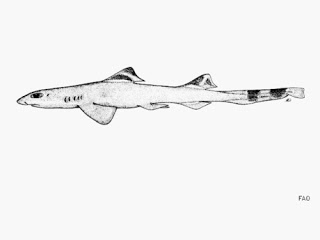
You would be hard-pressed to find someone today who has not seen the legendary Jaws movie. The movie defined a generation and solidified sharks as one of the most gruesome and dangerous killers on the planet. But such misconceptions are an injustice to this diverse, and often harmless, order of fish, some of which reach a mature length shorter than that of an average housecat.
Case in point: Meet
Eridacnis radcliffei, also known by the common name of the Pygmy Ribbontail Cat Shark, which, at 19-24 centimeters, is one of the smallest sharks in the world.
Eridacnis radcliffei is a member of the Carcharhiniformes order, “typical” sharks characterized by “long mouths, two dorsal fins without spines, an anal fin, and the eyes over the mouth.” These sharks differ from sharks in other orders “in having movable lower eyelids.”
Occuring around continental and insular shelves, the Pygmy Ribbontail Cat Shark is found in the western Indo-Pacific from Tanzania to the Philippines. Its diet consists mostly of bony fishes, crustaceans and squid. This species is of minimal importance to the fishing industry, being sometimes caught in bottom trawls off the coast of the Philippines but not typically sold in the industry. They are currently listed as “Least Concern” by the IUCN.
This week’s book of the week,
v. 24, n. 4 (1981) of
Oceanus, contains a very interesting article by Leonard J. V. Compagno, entitled “
Legend versus Reality: The Jaws Image and Shark Diversity.” In it, he tackles the widely-accepted conception that all sharks are behemoths that can be “typified by large and powerful species.” Such impressions have been encouraged by the advent of films such as
Jaws and
Deep Blue Sea, which represent sharks as monstrous goliaths capable of, should they so choose, swallowing humans whole.
Within this article, Compagno takes an objective look at the superorder of Selachimorpha – sharks – finding that, in the 296 shark species that he studied, only about 4% were more than 4 meters long. And our friend, the Pygmy Ribbontail Cat Shark, gets its moment in the spotlight on pages
15–
16, were it is highlighted as one of the smallest shark species in the world.
Take a few moments to flip through
Compagno’s article, possibly re-evaluating your conception of the shark as a giant killer to the beautifully diverse range of aquatic species that it is. And to learn even more about our highlighted species, the Pygmy Ribbontail Cat Shark, explore
its page on the
Encylopedia of Life.
This week’s book of the week,
v. 24, no. 4 (1981) of
Oceanus, was contributed by the MBL WHOI library.






Leave a Comment